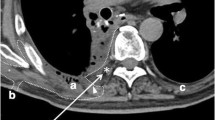Abstract
Purpose
Articles evaluating radiofrequency (RF) safety are insufficient. Thus, the purpose of this study was to investigate RF safety during biportal endoscopic lumbar decompressive laminotomy by measuring epidural temperature after RF use.
Methods
Both in vitro cadaveric study and in vivo study were performed. The epidural temperature was measured at epidural space after RF use in three cadavers. The epidural temperature was measured and analysed according to RF mode, RF power, RF usage time, and saline irrigation patency. In the in vivo study, the epidural temperature was measured after biportal endoscopic surgery. Epidural temperatures were measured around ipsilateral and contralateral traversing nerve roots after 1-s use of RF.
Results
In the in vivo study, epidural space temperature was increased by 0.31 ± 0.16 °C ipsilaterally and 0.29 ± 0.09° contralaterally after RF use in coagulation mode 1. The epidural temperature of epidural space was increased by 0.21 ± 0.13 °C ipsilaterally and 0.15 ± 0.21 °C contralaterally after RF use in high mode 2. In the in vitro study, epidural temperature was significantly increased with a long duration of RF use and a poor patency of irrigation fluid.
Conclusion
The use of RF in biportal endoscopic spine surgery might be safe. In order to reduce indirect thermal injuries caused by RF use, it might be necessary to reduce RF use time and maintain continuous saline irrigation patency well.





Similar content being viewed by others
References
Ohyama S, Takahashi S, Tamai K, Hori Y, Hirakawa Y, Hoshino M, Suzuki A, Nakamura H (2019) Prevention of nerve root thermal injury caused by bipolar cauterization near the nerve roots. Spine 44:E321-e328. https://doi.org/10.1097/brs.0000000000002846
Konno S, Olmarker K, Byröd G, Nordborg C, Strömqvist B, Rydevik B (1994) The European Spine Society AcroMed Prize 1994. Acute thermal nerve root injury. Eur Spine J Official Publ Eur Spine Soc Eur Spinal Deform Soc Eur Sect Cerv Spine Res Soc 3:299–302. https://doi.org/10.1007/bf02200140
Heo DH, Park DY, Hong HJ, Hong YH, Chung H (2022) Indications, contraindications, and complications of biportal endoscopic decompressive surgery for the treatment of lumbar stenosis: a systematic review. World Neurosurg 168:411–420. https://doi.org/10.1016/j.wneu.2022.09.023
van Eck CF, van Meel TAC, van den Bekerom MPJ, Zijl JAC, Kooistra B (2021) Heat-related complications from radiofrequency and electrocautery devices used in arthroscopic surgery: a systematic review. Arthrosc Sports Med Rehabil 3:e605–e613. https://doi.org/10.1016/j.asmr.2020.12.002
Lee HJ, Heo DH, Han SK, Choi HW, Kim S, Cho BC, Song MC, Yang SC, Lee KM, Lee MH, Yoon TH, Shin JH, Lee WC, Park JY (2022) Thermal dynamics of a novel radio-frequency device for endoscopic spine surgery: an experimental model. Spine 47:720–729. https://doi.org/10.1097/brs.0000000000004320
Heo DH, Lee DC, Kim HS, Park CK, Chung H (2021) Clinical results and complications of endoscopic lumbar interbody fusion for lumbar degenerative disease: a meta-analysis. World Neurosurg 145:396–404. https://doi.org/10.1016/j.wneu.2020.10.033
Heo DH, Hong YH, Lee DC, Chung HJ, Park CK (2020) Technique of biportal endoscopic transforaminal lumbar interbody fusion. Neurospine 17:S129-s137. https://doi.org/10.14245/ns.2040178.089
Wong KL, Williams GR (2001) Complications of thermal capsulorrhaphy of the shoulder. J Bone Joint Surg Am 83(2):151–155. https://doi.org/10.2106/00004623-200100022-00013
Derriks JHG, Hilgersom NFJ, Middelkoop E, Samuelsson K, van den Bekerom MPJ (2020) Electrocautery in arthroscopic surgery: intra-articular fluid temperatures above 43 °C cause potential tissue damage. Knee Surg Sports Traumatol Arthrosc 28:2270–2278. https://doi.org/10.1007/s00167-019-05574-4
Huang Y, Zhang Y, Ding X, Liu S, Sun T (2014) Working conditions of bipolar radiofrequency on human articular cartilage repair following thermal injury during arthroscopy. Chin Med J (Engl) 127:3881–3886
Xu D, Pollock M (1994) Experimental nerve thermal injury. Brain 117(Pt 2):375–384. https://doi.org/10.1093/brain/117.2.375
Yu X, Liu C, Ji C, Lenahan C, Fang Y, Wang Y, Shao A (2022) Changes of functional, morphological, and inflammatory reactions in spontaneous peripheral nerve reinnervation after thermal injury. Oxid Med Cell Longev 2022:9927602. https://doi.org/10.1155/2022/9927602
Hong YH, Kim SK, Hwang J, Eum JH, Heo DH, Suh DW, Lee SC (2021) Water dynamics in unilateral biportal endoscopic spine surgery and its related factors: an in vivo proportional regression and proficiency-matched study. World Neurosurg 149:e836–e843. https://doi.org/10.1016/j.wneu.2021.01.086
Acknowledgements
Dong Hwa Heo and Don Young Park were co-first authors and equally contributed to this paper.
Funding
This research was supported by a grant of Patient-Centred Clinical Research Coordinating Centre (PACEN) funded by the Ministry of Health and Welfare, Republic of Korea (grant number: HC20C0163).
Author information
Authors and Affiliations
Corresponding author
Ethics declarations
Conflict of interest
Dr Jin-Sung Kim is consultant in RIWOSpine, (GmbH, Germany) and Elliquence (LLC, USA).
Ethics approval
Approval obtained from Institutional review board.
Additional information
Publisher's Note
Springer Nature remains neutral with regard to jurisdictional claims in published maps and institutional affiliations.
Rights and permissions
Springer Nature or its licensor (e.g. a society or other partner) holds exclusive rights to this article under a publishing agreement with the author(s) or other rightsholder(s); author self-archiving of the accepted manuscript version of this article is solely governed by the terms of such publishing agreement and applicable law.
About this article
Cite this article
Heo, D.H., Park, D.Y., Hong, Y.H. et al. Temperature change of epidural space by radiofrequency use in biportal endoscopic lumbar surgery: safety evaluation of radiofrequency. Eur Spine J 32, 2769–2775 (2023). https://doi.org/10.1007/s00586-023-07719-z
Received:
Revised:
Accepted:
Published:
Issue Date:
DOI: https://doi.org/10.1007/s00586-023-07719-z




